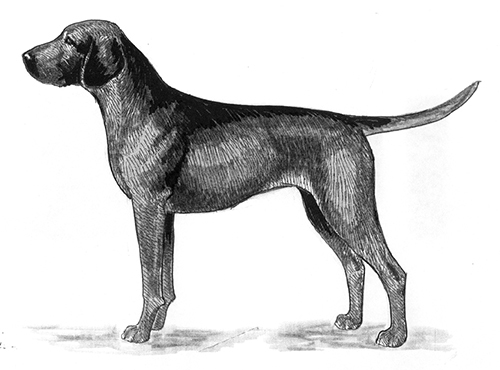Hanoverian Hound
Scenthound Group
The goals and purposes of this breed standard include: to furnish guidelines for breeders who wish to maintain the quality of their breed and to improve it; to advance this breed to a state of similarity throughout the world; and to act as a guide for judges.
Breeders and judges have the responsibility to avoid any conditions or exaggerations that are detrimental to the health, welfare, essence and soundness of this breed, and must take the responsibility to see that these are not perpetuated.
Any departure from the following should be considered a fault, and the seriousness with which the fault should be regarded should be in exact proportion to its degree and its effect upon the health and welfare of the dog and on the dog’s ability to perform its traditional work.
History
The Hanoverian Scenthound originated in Germany. It has developed nearly unchanged from the so-called Liam Hound of the early middle Ages. With the invention of firearms, dogs were needed to search for wounded game. The Hanoverian Hunting Estate in the kingdom of Hannover developed this hound and their breeding has been strictly with regard to their working ability. They are used exclusively as specialists for tracking cloven hoofed game.
The Hanoverian was recognized by the United Kennel Club January 1, 1996.
General Appearance
A medium sized, well proportioned, and powerful breed, well suited for work.
Characteristics
Calm and assured, with a high capability to concentrate on any track.
Head
The forehead is slightly wrinkled.
SKULL
The skull is broadest between the ears, and slightly rounded. The occiput is not prominent. The stop is strongly pronounced, especially in males.
MUZZLE
The muzzle is strong, deep and broad, as long as the skull. The lips are broad, pendulous and well rounded. The cheeks are strongly muscled.
TEETH
The Hanoverian has a complete set of evenly spaced, white teeth meeting in a scissors or level bite.
Faults: Undershot or overshot bite.
NOSE
Broad and usually black, but occasionally dark brown.
EYES
The eyes are dark brown, with well fitted lids.
Faults: Entropion or ectropion.
EARS
The ears are set on high. They are broad and smooth, hanging close to the head without a twist.
Neck
The neck is long and strong. The skin on the throat is loose. A slight dewlap is permissible.
Forequarters
The shoulder blades are flat, close and well laid back. The upper arms are long, setting the legs under the body.
FORELEGS
The legs are straight and often stand fairly close together. The length of the leg, from the elbow to the ground, is one-half the height at the withers. The elbows set close to the body. The pasterns are sloping.
Body
The body is slightly longer than tall. The chest is deep rather than broad. The back is strong, and the topline is long. The loin is broad and pliable, with a slight arch. The croup is long, broad and slightly sloping. There is a slight tuck up that rises gradually.
Fault: Square build.
Hindquarters
The hindquarters are well angulated. The pelvis is broad and capacious.
HIND LEGS
The upper thighs are strongly muscled. The stifle is well angulated, and the lower thigh is straight and lean. The hock joint is broad and strong, and the rear pasterns are vertical.
Feet
Strong and round, with large, thick pads and well arched toes.
Tail
High set, long and barely curved, tapering to the tip.
Coat
The coat is short and thick, coarse to harsh. Somewhat longer and coarser on the back of the thighs and underside of tail.
Color
Light to dark deer red, more or less intensely brindled, with or without a face mask. Small white patches on the chest are tolerated.
Height and Weight
Height for males is 19.5 to 21.5 inches at the withers. For females, it is 19 to 21 inches.
Weight for males is 66 to 88 pounds. For females, it is 55 to 77 pounds.
Gait
Flexible and ground covering, with strong drive.
Disqualifications
(A dog with a Disqualification must not be considered for placement in a conformation event, and must be reported to UKC.)
Unilateral or bilateral cryptorchid.
Viciousness or extreme shyness.
Albinism.

Looking for a Dog?
Find a dog that will fit your family.
Note: The breeders on this list are not endorsed by UKC.
©Copyright 1996, United Kennel Club
